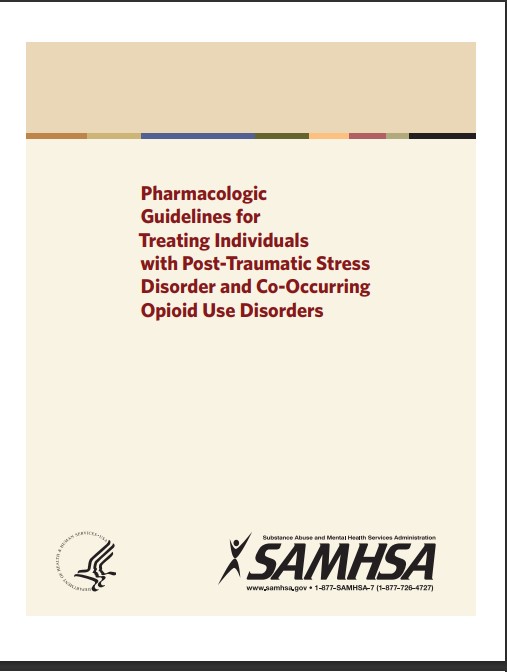Pharmacologic Guidelines

Pharmacologic Guidelines for Treating Individuals with Post-Traumatic Stress Disorder and Co-Occurring Opioid Use Disorders
Pharmacologic Guidelines – Individuals with co-occurring mental and substance use disorders (COD) are common in behavioral health and primary health settings. These individuals frequently benefit from pharmacologic interventions, whether for mental disorders, substance use disorders, or both.
While principles for providing COD services establish a framework for prescribing pharmacologic agents to individuals diagnosed with COD, specific combinations of disorders have unique features that must be considered in developing pharmacologic strategies.
Currently, there are no documents that address Post Traumatic Stress Disorder (PTSD) and co-occurring opioid use disorders in a brief, easy-to-use format that provides guidance to both frontline practitioners, as well as to system or program policymakers.
As a companion to the Substance Abuse and Mental Health Services Administration’s (SAMHSA’s) General Principles for the Use of Pharmacological Agents to Treat Individuals with Co-Occurring Mental and Substance Use Disorders, this document provides guidelines for pharmacologic interventions for individuals with PTSD and co-occurring opioid use disorders.
Introduction
The co-occurrence of PTSD and co-occurring opioid use disorders was selected for guideline development because of the high rates of trauma in substance users and high rates of PTSD amongst those with substance use disorders…
The lifetime prevalence of PTSD in adults in the United States is approximately 7 percent (Hildago & Davidson, 2000; Kessler, Berglund, et al., 2005), and past year prevalence is about 4 percent (Kessler, Chiu, et al., 2005).
The lifetime prevalence of PTSD among women (9.7%) is 2.5 times that of men (3.6%), and the 12-month prevalence for women (5.2%) is nearly three times that of men (1.8%) (National Comorbidity Survey, 2005).
Veterans have a greater prevalence of PTSD than the general population. Lifetime prevalence for Vietnam veterans is 30.9 percent for men and 26.9 percent for women, with current prevalence of 15.2 percent for men and 8.1 percent for women (Kulka et al., 1990). Veterans from the Afghanistan and Iraq wars have a current PTSD prevalence of approximately 14 percent (Tanielian & Jacox, 2008).
Among those with PTSD, substance use disorders occur in 21-43 percent of the population (Jacobson et al., 2001). In those with substance use disorders, lifetime prevalence of PTSD ranges from 26-52 percent (Mills et al., 2005; Reynolds et al., 2005), and current PTSD ranges from 15-41 percent (Clark et al., 2004; Dom et al., 2007; Schafer & Najavits, 2007).
Some of the most problematic substances of abuse in PTSD are opioids. For example, for returning veterans from Iraq and Afghanistan, both the widespread availability of opioids and their use in managing the pain of injured soldiers will likely increase the prevalence of this co-occurring condition in clinical settings in this country.
Untreated PTSD in opioid dependent individuals receiving opioid dependence therapies (methadone or buprenorphine maintenance, detoxification treatment, and drug-free residential treatment) has been associated with ongoing mental, physical, and occupational disability, despite improvements in substance abuse (Mills et al., 2007).
Symptoms of PTSD do not improve with opioid therapy in those with co-occurring PTSD and opioid dependence (Trafton et al., 2006). Therefore, it is important to screen those presenting for treatment with opioid dependence for co-occurring PTSD.
Likewise, it is important to screen those with trauma symptoms for concurrent opioid abuse. It is essential to develop a treatment plan that will appropriately address both disorders.
Effective treatments for PTSD in individuals with opioid disorders include both psychosocial interventions (e.g., relapse prevention, contingency management, prolonged exposure, and teaching coping skills) and pharmacotherapies.
The types and sequencing of these modalities will vary between individuals and be influenced by individual choice. Prescribers should discuss risks and benefits of medications so every individual can make an informed choice regarding different treatment options. Psychosocial interventions are key to effective treatment of both conditions.
They serve to educate individuals about both disorders, improve awareness on how these problems interact to contribute to poor outcomes, and assist in the development of coping skills to manage PTSD and opioid use disorder symptoms (both in the early and later phases of treatment).
A review of effective psychosocial interventions is beyond the scope of these guidelines (publications and practice guidelines are located at http://apa.org/pubs and http://www.psych.org).
READ MUCH MORE INSIDE…
“Pharmacologic Guidelines for Treating Individuals with Post-Traumatic Stress Disorder and Co-Occurring Opioid Use Disorders”
![]()

Click on the Blue Button Below for Instant Access!
Our 100% Money Back Guarantee:

If for any reason you decided within 30 days that
“Pharmacologic Guidelines for Treating Individuals with Post-Traumatic Stress Disorder and Co-Occurring Opioid Use Disorders” isn’t for you, simply notify us by email and we’ll gladly refund your money – no questions asked.
That’s our Ironclad Guarantee! The risk is entirely ours! You absolutely have nothing to lose!
Your name and email will Never be shared, sold, or given to anyone.
We keep our subscriber’s privacy sacred. We do not sell or rent your personal information to other parties. What’s more you can always unsubscribe at any time!
Warmest Regards, Coyalita
Behavioral Health Rehabilitative Specialist & Addiction Counselor
Copyright © 2021-2024 Thresholdlivecoyalita.com All Rights Reserved Privacy Policy – Earnings Disclaimer – Terms of Use – Contact Us




